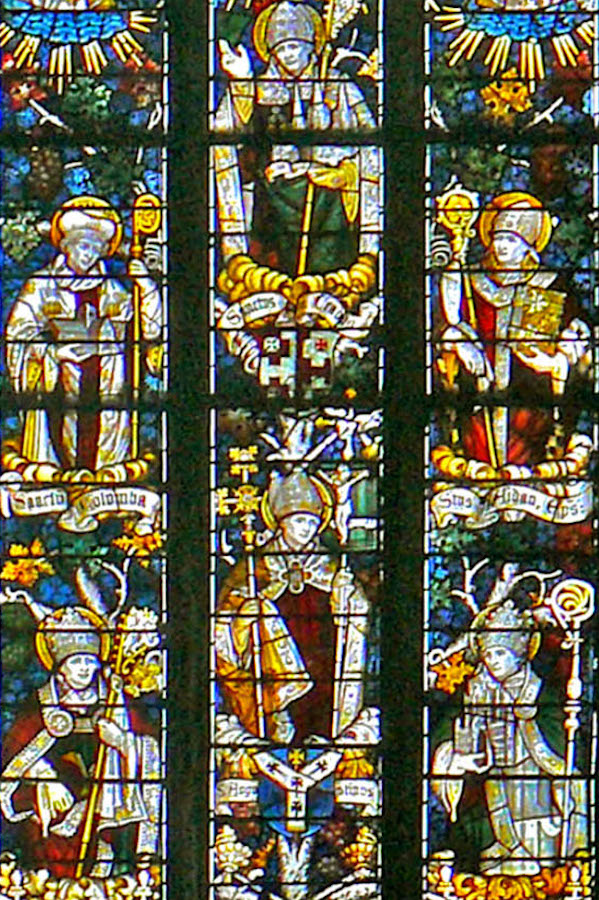
The Tree of the Church, by Charles Eamer Kempe, in the south transept of Lichfield Cathedral, 1895. This was the first important work of Kempe's new draughtsman, John Lisle, whom he had schooled in stained glass design himself, since first having been introduced to him as a sixteen-year-old student at the Lambeth school of art. Adrian Barlow describes the window as "one of the finest achievements not simply of the Studio but of nineteenth-century stained glass as a whole" (Espying Heaven, 26).


Left: The central figures in the upper part of the window: Christ in Glory surrounded by four of altogether eight angels (besides those in the tracery). Right: Lichfield's patron saint, St Chad, seen immediately below him, holding a model of the cathedral, with St Columba and St Aidan either side of him.
Below St Chad is St Augustine of Canterbury, flanked by St Wilfred of Worcester and St Hugh of Lincoln. These and the other figures all have their identifying accoutrements and garb, and there is a good deal of heraldry too — this being another subject in which Kempe felt a keen interest. The window is therefore a tour de force of church history and its iconography. Kempe's knowledge of all this was immense. Such windows were used for teaching in the early days of the church, but it would require exceptionally good sight and a good deal of commitment to use this window as a visual guide to its subject now.


High in the tracery are Kempe's wheatsheaves (lower row, far left), and the monogram of his Master Glazier, Alfred Tombleson (1852-1943), with a large "T" in the middle (upper row, far right, hardly visible from the church floor). Over Kempe's wheatsheaves hangs a bunch of grapes, a motif found throughout, in keeping with the idea of the richly fruiting vine, the roots of which appear at the bottom of the window, along with the Latin text from John 15, 5 ("I am the vine, ye are the branches") which continues, "He that abideth in me, and I in him, the same bringeth forth much fruit...." As for Tombleson's monogram, acknowledging his indispensable role in producing such a complex piece of work, this is only found on some of the especially important later windows.
Photographs by Colin Price. Text and formatting by Jacqueline Banerjee. You may use the images without prior permission for any scholarly or educational purpose as long as you (1) credit Colin Price and (2) link your document to this URL in a web document or cite the Victorian Web in a print one. Click on the images to enlarge them.
Related Material
- Lichfield Cathedral, Interior (this gives links to other stained glass windows there)
Bibliography
Barlow, Adrian. Espying Heaven: The Stained Glass of Charles Eamer Kempe and His Artists. Cambridge: Lutterworth, 2019. [Review]
Created 19 February 2019